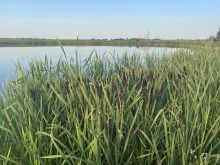The definition of a lagoon is pretty straight forward as far as the Saskatchewan health ministry is concerned.
“A lagoon is a large gently sloped basin in the ground that is designed to contain sewage,” it says.
“The liquid is disposed of through evaporation, while the solids are retained and broken down by micro-organisms.”
However, livestock operators still have a lot of regulatory, environmental and production related factors to think about before digging a hole.
Location, soil type and nearby neighbours and municipalities will influence the design, structure and cost of a new lagoon.
Read Also

Europe holds promise for Canadian lentils
Pulse Canada is trying to help boost lentil consumption in Europe, which is already the fourth largest market.
Producers will have to work with officials and engineers to establish the dimensions and slopes of the structure to meet the demands of provincial regulators.
They’ll have to determine its storage capacity and maximum hydraulic conductivity, and they will need a plan to keep water from running off and running in.
Chris Ullmann of Alberta Agriculture said the challenges are the same whether it’s a dairy or hog operation.
“You generally don’t want a site where you’re going to have neighbours that are nearby because either you’re not going to be able to build now, or maybe in the future you want to expand and those neighbours may limit your ability to expand,” he said.
However, site specific factors will determine what kind of liner an operator uses to keep liquid manure in the lagoon and out of ground and surface water.
As an intensive livestock operation extension specialist, Ullmann helps producers make these decisions and ensure they adhere to the provincial legislation.
“We have kind of a hierarchy of layers and liners that meet the regulations, but as you go up that hierarchy, there tends to be a greater cost,” said Ullmann.
Producers with the right location can get away with a naturally occurring protective layer, but they’ll need a fortunate combination: a lot of clay — 10 metres thick in Alberta — and shallow groundwater.
“If he’s sitting on gravel, then we know we need to look for something else.”
Ullmann said most producers opt for a compacted soil liner, bringing clay onto the site and building a one metre thick layer. This is usually the most economical option.
Other producers may opt for a synthetic liner, using a polyvinyl chloride or high density polyethylene liner as a barrier.
“I usually tell people to shop around on that as well,” he said.
“There’s different thicknesses. There’s different liner types. It kind of fluctuates a bit with the price of oil, too.”
Several products are available at different thicknesses with units measured in millimetres. With these manmade options, producers must have a plan to protect and maintain the liner.
“Synthetic liners are great, but they also have other complications, because they are very thin,” he said.
“They’re easy to tear, so you still need to put in ramps. You need to put in agitation pads and you need to be careful that you don’t tear those liners.
“There’s more reasons than just economics, but economics is definitely part of it.”














